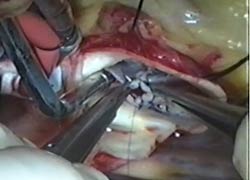
Most patients with aortic valve insufficiency from either tri-leaflet or bicuspid aortic valves are candidates for repair, in addition to selected patients with mixed aortic stenosis and insufficiency. Initially, annuloplasty is performed with commissural annuloplasty to reduce valve diameter to 19-21 mm. Leaflet prolapse is corrected with plication stitches, placed in the free edge of each leaflet adjacent to the Nodulus Arantius. In this regard, the free edge functions as the chorda tendinea of the aortic valve, and shortening with plication stitches raises the leaflet to a proper “effective height”. Leaflet defects are augmented with autologous pericardium, and mild-to-moderate calcium is removed with the CUSA ultrasonic aspirator.
Using these methods, most insufficient aortic valves, and many with mixed lesions, can be satisfactorily repaired. Five cases will be shown, spanning the spectrum from annular dilatation without leaflet defects, to congenital bicuspid valve with prolapse, to tri-leaflet prolapse, to unusual bicuspid pathology with calcification, to a moderately calcified tri-leaflet valve with mixed lesions. All valves were repaired with trivial residual leak and minimal gradients.
Using commissural annuloplasty, leaflet plication, pericardial augmentation, and selective decalcification, most insufficient aortic valves now can undergo repair. Late valve-related complications are minimal. Generalization of these techniques and a greater application of aortic valve repair seem indicated.
Disclosure: Dr. Rankin is a Consultant and Equity Holder in BioStable Science and Engineering (BSE) – A company designed to develop new aortic valve repair devices. No products of this company are described or used in this video.



